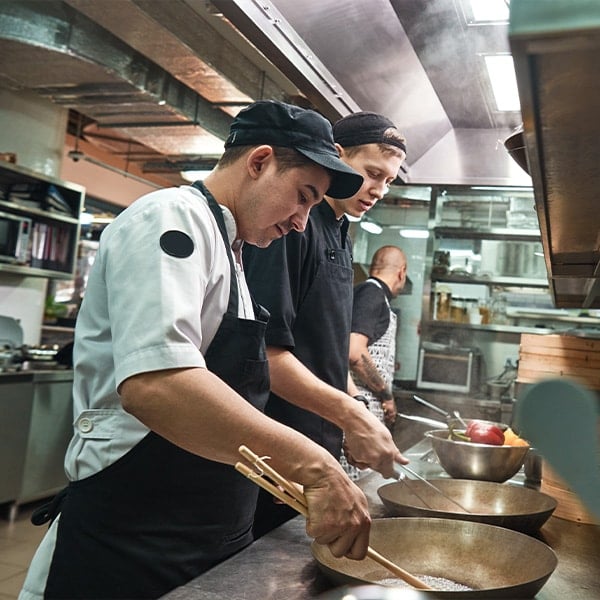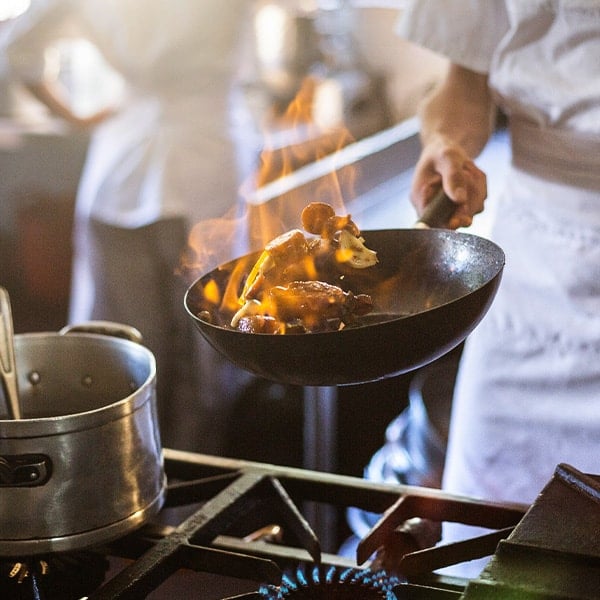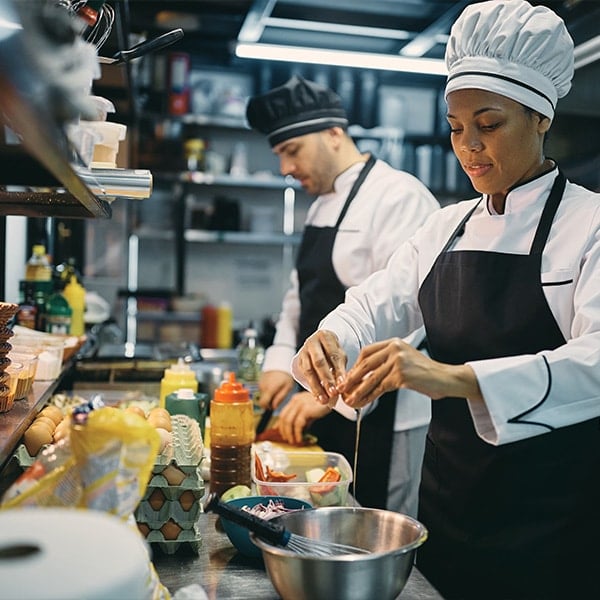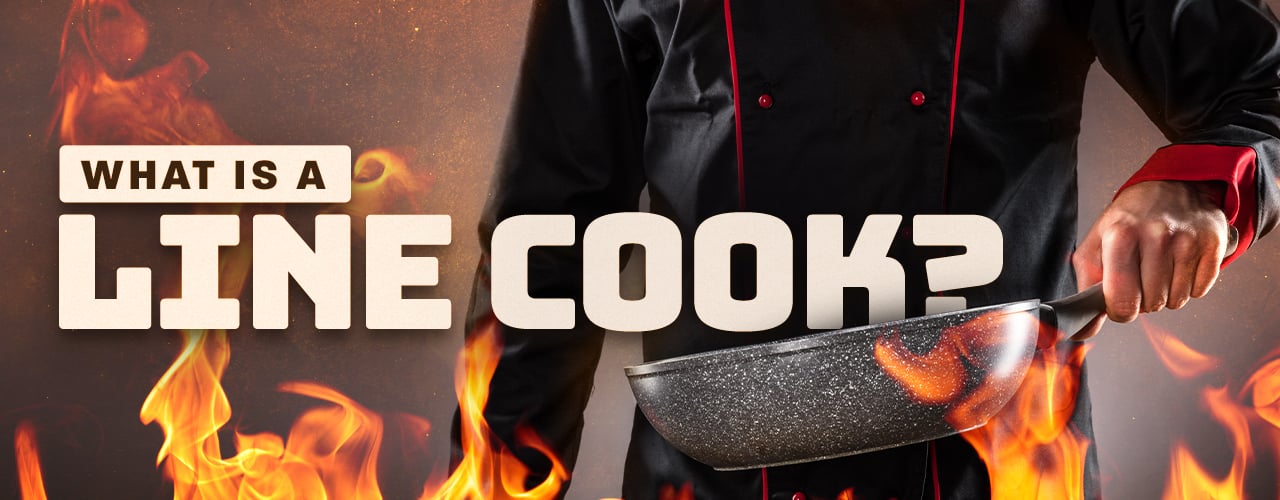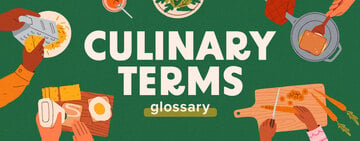To fully appreciate and excel in the culinary world, it is essential to understand the vast array of culinary terms and techniques used in professional kitchens. Whether you are a seasoned chef, a culinary student, or a food enthusiast looking to expand your knowledge, having a comprehensive understanding of culinary terminology is crucial. From basic cooking methods to specialized techniques, this glossary will help you navigate the intricate world of culinary arts with confidence and precision.
Use these links to expand your culinary vocabulary and learn new terms:
A-D Culinary Terms
E-I Culinary Terms
J-Q Culinary Terms
R-Z Culinary Terms
A-D Culinary Terms
A
A la carte - A term commonly used in restaurants to describe a menu where each dish is priced separately. This allows customers to order individual items rather than choosing a set meal.
A la mode - A French term that means "in the fashion" or "according to the current style." In culinary terms, a dish served a la mode typically refers to a dessert topped with a scoop of ice cream. This combination of warm dessert and ice cream creates a delightful contrast in temperature and texture, making it a popular choice for indulgent treats.
Al dente - An Italian term that translates to "to the tooth," referring to the ideal texture of pasta when it is cooked to be firm but not overdone. Pasta cooked al dente should have a slight resistance when bitten into, offering a satisfying chewiness.
B
Back of House - A term referring to the area in a commercial kitchen where food preparation and cooking take place. The back of house is the heart of any foodservice operation, where chefs and kitchen staff work diligently to create delicious dishes for customers.
Bake - A cooking method that uses dry heat, typically in an oven, to cook food items such as bread, pastries, and casseroles.
Baste - The process of moistening food while it is cooking to add flavor, preventing drying out, and enhancing tenderness. This technique involves using a liquid, such as melted butter or pan juices, to continually coat the food during the cooking process.
Beat - To vigorously mix ingredients together using a whisk, mixer, or other utensil to incorporate air and create a smooth, uniform texture. This technique is commonly used when making batters, sauces, and desserts in commercial kitchens.
Boil - A cooking method that involves heating a liquid to its boiling point, where bubbles form and rise to the surface. This technique is used to cook food quickly, soften ingredients, and infuse flavors in soups, sauces, and pasta dishes in commercial kitchens.
Brine - The process of soaking food in a solution of salt and water to enhance flavor, tenderness, and moisture retention. This technique is commonly used for meats, poultry, and seafood in commercial kitchens to create juicy and flavorful dishes.
Broil - A cooking method that uses direct heat from above to cook food quickly at high temperatures. This technique is ideal for cooking meats, seafood, and vegetables in commercial kitchens, creating a caramelized exterior and juicy interior.
C
Caramelize - A cooking technique where sugar is heated until it melts and turns into a golden-brown liquid. Can also refer to the browning of food, adding a rich flavor and color to dishes such as onions, fruits, and meats.
Chafing Dish - A chafing dish is a type of serving dish that uses indirect heat to keep food warm during service. They are commonly used for buffet-style events and are available in various sizes and styles.
Charcuterie - Selection of cured meats, preserved meats, and pates that are typically served on a board with accompaniments like cheeses, fruits, and nuts.
Chop - Technique used to cut food into small, irregular pieces. This method is commonly used for vegetables, herbs, and nuts and is the first step in many recipes.
Comp - Term used in the restaurant industry to refer to providing a complimentary meal to a guest.
Core - To remove the central, often inedible, part of the produce. This process is commonly done to apples, pears, and tomatoes.
Cube -To cut food into small, uniform cubes. This method is often used for ingredients like vegetables, meat, and cheese to ensure even cooking and presentation.
D
Dash - A small amount of an ingredient, usually around a teaspoon, that is added for flavor enhancement. It is a measurement that is less precise than a pinch but still imparts a noticeable taste to a dish.
Drizzle - Culinary technique that involves pouring a thin stream of liquid over food in a controlled manner. This is typically done to add flavor, moisture, or visual appeal to a dish.
Dutch Oven - A heavy-duty cooking pot with thick walls and a tight-fitting lid, usually made of cast iron or enameled cast iron. This versatile cookware is ideal for braising, stewing, roasting, and baking, making it a staple in many commercial kitchens.
Back to Top
E-I Culinary Terms
E
Emulsify - Combining two or more liquids that typically do not mix well together. This technique creates a stable mixture by dispersing one liquid into another with the help of an emulsifier, such as egg yolks or mustard.
Entree - This course is typically served after the appetizer or starter and before the dessert. It is often the focal point of the meal and can feature a variety of proteins, such as meat, poultry, fish, or vegetarian options.
F
Filet - A piece of meat or fish that has been deboned and often cut into a boneless, flat shape. A common technique used to prepare proteins for cooking by removing bones and skin.
Fold - Technique used in cooking and baking to gently combine ingredients without deflating or overmixing them. This method is often used when incorporating whipped egg whites or delicate ingredients to make dishes like souffles, mousse, and chiffon cakes.
Fondant - A type of icing or frosting commonly used in cake decorating. It is made from sugar, water, and gelatin and has a smooth, pliable texture that can be rolled out and draped over cakes to create a flawless finish.
Front of House - The area where guests are served and interact with staff. This includes the dining room, bar, reception area, and any other spaces where customers receive service.
G
Glaze - A liquid mixture applied to food to add flavor, moisture, and a glossy finish. Glazes are often made from ingredients like sugar, honey, vinegar, or fruit juices.
Grate - To shred into small pieces using a grater, a kitchen tool with sharp-edged holes. Grated ingredients like cheese, vegetables, and citrus zest are commonly used in various dishes to add texture and flavor.
Grease - Fats or oils used for cooking or lubricating cooking surfaces. Grease is often used to prevent food from sticking to pans or grills and to add flavor and moisture to dishes.
Griddle - A flat cooking surface typically made of metal or stone that is heated from below. Griddles are versatile tools in commercial kitchens and are used to cook foods like pancakes, eggs, burgers, and sandwiches.
Grill - A cooking surface with metal bars or ridges where food is placed directly over heat. Grilling imparts a distinct charred flavor to food and is commonly used for cooking meats, vegetables, and seafood.
H
Hors D'oeuvre - Small, bite-sized food items served before a meal to stimulate the appetite. These appetizers can be hot or cold and are often served on platters or passed around at events.
Hygiene - The practices and protocols followed to ensure the cleanliness and safety of food preparation areas, equipment, and personnel. Maintaining high standards of hygiene is crucial to prevent foodborne illnesses and ensure the quality of food products.
I
In the Weeds - Kitchen slang term used to describe a situation where a chef or kitchen staff member is overwhelmed with a high volume of orders or tasks, leading to a state of being behind schedule or feeling stressed.
Induction - A cooking method that uses electromagnetic energy to heat cookware directly, rather than relying on a traditional gas flame or electric heating element. This technology allows for precise control over temperature and is known for its efficiency and speed in commercial kitchens.
Infusion - A culinary technique that involves steeping ingredients such as herbs, spices, fruits, or vegetables in a liquid (such as water, oil, or alcohol) to extract their flavors. This process allows the liquid to take on the essence of the infused ingredients, adding depth and complexity to dishes or beverages.
Back to Top
J-Q Culinary Terms
J
Jambalaya - A traditional Creole and Cajun dish from Louisiana that typically consists of a mixture of rice, meat, and vegetables.
Julienne - A culinary term that refers to cutting fruits, vegetables, or meats into long, thin strips. This knife-cutting technique is commonly used in food preparation to create uniform pieces for cooking or garnishing dishes.
K
Knead - A fundamental technique in baking that refers to the process of working dough with the hands to develop gluten. This action helps create structure and elasticity in the dough, resulting in a lighter and more uniform texture in the final baked product.
Kosher - Food products that adhere to Jewish dietary laws. These laws dictate what foods can and cannot be consumed and how they must be prepared. Foods that are labeled as kosher have been prepared in accordance with these guidelines and have been certified by a kosher certification agency.
L
Lard - A type of fat that is rendered from pig fat. Lard has a high smoke point, making it ideal for frying and sauteing.
Leaven - A substance that causes dough to rise and become light and airy. Common leavening agents include yeast, baking powder, and baking soda
Legume - A type of plant in the pea family that includes beans, lentils, and peas. Legumes are commonly used in soups, stews, salads, and side dishes.
M
Marinate - To soak food in a seasoned liquid mixture to enhance its flavor or tenderize it. Marinating is a common technique used in commercial kitchens to infuse proteins such as meat, poultry, or seafood with additional taste.
Mignonette - A classic French sauce that is commonly served with oysters. This tangy and flavorful sauce is typically made with a combination of minced shallots, cracked black pepper, and vinegar, often using red wine vinegar or champagne vinegar for a unique taste.
Mother Sauce - Mother sauces are the foundation of classical French cuisine, serving as the base for a variety of derivative sauces. There are five primary mother sauces: Bechamel, Veloute, Espagnole, Tomato, and Hollandaise.
N
Nigiri - A classic Japanese dish similar to sashimi that consists of a small ball of vinegared sushi rice topped with a slice of raw fish or seafood. The word "nigiri" translates to "two fingers" in Japanese, referring to the way the rice is shaped by hand.
O
Orzo - A small, rice-shaped pasta that is commonly used in a variety of culinary dishes. Despite its appearance, orzo is made from wheat flour, making it a type of pasta rather than a grain.
P
Parboil - Cooking technique where food items are partially cooked in boiling water or broth. This process helps reduce cooking time for items like potatoes or vegetables that normally have to be cooked for a long time.
Pasteurization - Heat treatment process that eliminates harmful bacteria from food and beverages, ensuring safety and extending shelf life. Commonly used for dairy products and juices, pasteurization helps maintain product quality and freshness.
Pate - Smooth and creamy mixture of seasoned ground meat, poultry, or seafood. This versatile dish can be served as a spread, appetizer, or filling for pastries, adding a rich and savory flavor to various dishes.
Peel - The process of removing the outer skin or rind from fruits and vegetables before cooking or consuming them. This step helps improve the appearance, texture, and flavor of the produce, making it more appealing and easier to eat.
Pipe - Technique used in pastry and cake decorating where a mixture like frosting or dough is placed in a piping bag and squeezed through a nozzle to create decorative designs. This method allows for precise and intricate decorations on baked goods.
Poach - Gently cooking food in a simmering liquid such as water, broth, or wine. This method is commonly used for delicate foods like eggs, fish, or fruits, resulting in a tender and flavorful end product.
Puree - Blending or processing cooked or raw foods into a smooth and uniform consistency. This technique is commonly used for soups, sauces, baby food, and desserts, creating silky textures and concentrated flavors.
Q
Quick-Service Restaurant (QSR) - Also known as fast-food restaurants, quick-service restaurants are a type of restaurant that offer expedited and convenient food options to customers. These restaurants typically have a limited menu, focus on speed of service, and often feature self-service options for ordering and payment.
Back to Top
R-Z Culinary Terms
R
Roast - A dry-heat cooking method that involves cooking food in an oven or over an open flame. This technique is commonly used for meats, poultry, vegetables, and even nuts to enhance their flavors through caramelization and Maillard reactions.
Roux - Thickening agent for sauces, soups, and stews. It is a mixture of equal parts flour and fat, traditionally butter, cooked together to form a smooth paste.
S
Saute - Cooking method that involves quickly cooking food in a small amount of oil or fat over high heat. This technique is commonly used to cook vegetables, meats, and seafood, resulting in a caramelized exterior and a tender interior.
Scald - Process of heating a liquid, such as milk or cream, to just below the boiling point. This technique is used to kill bacteria, dissolve ingredients, or prepare liquids for further cooking or baking.
Score -The practice of making shallow cuts or slashes on the surface of food, such as meat or bread, before cooking. This technique helps the food cook evenly, allows marinades to penetrate, and creates a decorative presentation.
Sear - Cooking technique that involves quickly cooking meat or seafood over high heat to caramelize the surface and lock in juices. This method is often used to add flavor and create a crispy exterior on proteins.
Shred - Act of cutting food into long, thin strips or pieces. This technique is commonly used with vegetables, cheeses, and proteins to create texture, enhance presentation, and facilitate even cooking.
Steep - The process of soaking an ingredient, such as tea leaves or herbs, in a liquid to extract flavor. This technique is often used in preparing beverages like tea or infusing flavors into broths and sauces.
Sweat - Gently cooking vegetables in a covered pan with a small amount of fat over low heat. This process helps release the natural juices of the vegetables, resulting in a soft and translucent texture.
T
Temper - The process of slowly raising the temperature of one ingredient by incorporating small amounts of a hot liquid or mixture. This technique is commonly used in recipes that involve adding hot liquids.
Toast - Process of browning or crisping food items using dry heat. Toasting can enhance the flavor and texture of various ingredients, such as nuts, bread, spices, or grains.
Truss - To secure poultry or other meats with butcher's twine or skewers before cooking. Trussing helps the meat maintain its shape during the cooking process, ensuring even cooking and a more appealing presentation.
U
Umami - One of the five basic tastes alongside sweet, sour, bitter, and salty. Foods rich in umami flavor often have a savory or meaty taste that enhances the overall complexity of a dish.
Unleavened - Bread or dough that does not contain a leavening agent, such as yeast or baking powder. Unleavened bread is commonly used in various culinary applications, including certain types of flatbreads, crackers, and tortillas.
V
Vinaigrette - A classic dressing made by emulsifying oil and vinegar along with other seasonings such as mustard, herbs, and salt. This versatile dressing is commonly used to enhance the flavor of salads, vegetables, and even meats.
W
Whip - To beat a mixture vigorously to incorporate air and create a light, fluffy texture. This technique is commonly used in baking and pastry-making to add volume and structure to ingredients such as cream, eggs, or butter.
Whisk - A whisk is a kitchen tool commonly used in commercial kitchens for tasks such as beating eggs, whipping cream, or mixing sauces.
Y
Yeast - A living microorganism that plays a vital role in fermentation, where it converts sugars into alcohol and carbon dioxide. In baking, yeast is commonly used to leaven bread, giving the food an airy texture.
Z
Zest - The outer, colored part of citrus fruit peel, typically obtained by using a zester or grater. Zest is commonly used to enhance the flavor of various recipes, from desserts like lemon meringue pie to savory dishes like lemon chicken. Also refers to the act of lightly grating the peel of a fruit.
Back to Top
Understanding culinary terms is essential for anyone working in the foodservice industry. Whether you are a chef, server, or manager, having a strong grasp of these terms can enhance communication, efficiency, and overall performance in a commercial kitchen. By familiarizing yourself with the terminology used in the culinary world, you can streamline operations, improve collaboration among team members, and elevate the quality of your dishes.
